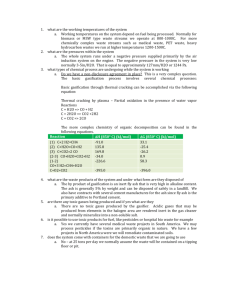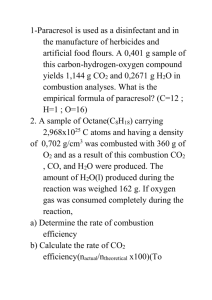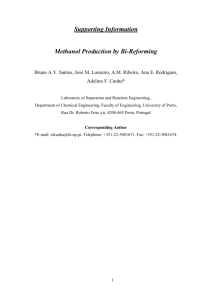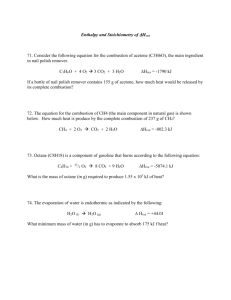line_HD189_CO2_paper..
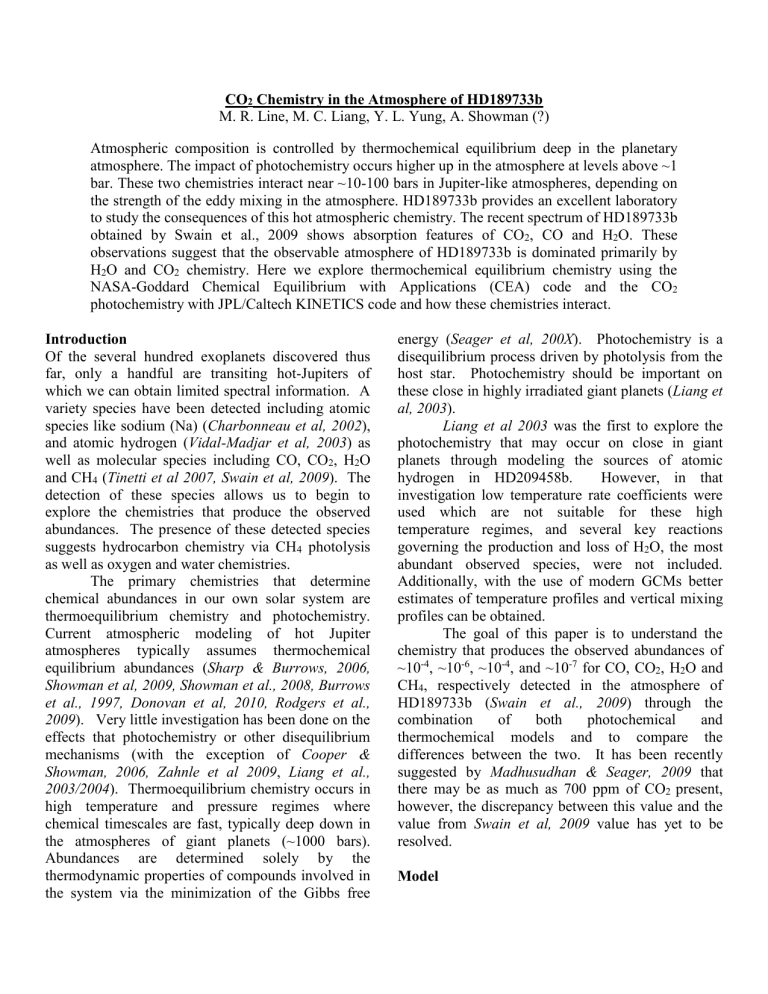
CO
2
Chemistry in the Atmosphere of HD189733b
M. R. Line, M. C. Liang, Y. L. Yung, A. Showman (?)
Atmospheric composition is controlled by thermochemical equilibrium deep in the planetary atmosphere. The impact of photochemistry occurs higher up in the atmosphere at levels above ~1 bar. These two chemistries interact near ~10-100 bars in Jupiter-like atmospheres, depending on the strength of the eddy mixing in the atmosphere. HD189733b provides an excellent laboratory to study the consequences of this hot atmospheric chemistry. The recent spectrum of HD189733b obtained by Swain et al., 2009 shows absorption features of CO
2
, CO and H
2
O. These observations suggest that the observable atmosphere of HD189733b is dominated primarily by
H
2
O and CO
2
chemistry. Here we explore thermochemical equilibrium chemistry using the
NASA-Goddard Chemical Equilibrium with Applications (CEA) code and the CO
2 photochemistry with JPL/Caltech KINETICS code and how these chemistries interact.
Introduction
Of the several hundred exoplanets discovered thus far, only a handful are transiting hot-Jupiters of which we can obtain limited spectral information. A variety species have been detected including atomic species like sodium (Na) ( Charbonneau et al, 2002 ), and atomic hydrogen ( Vidal-Madjar et al, 2003 ) as well as molecular species including CO, CO
2
, H
2
O and CH
4
( Tinetti et al 2007, Swain et al, 2009 ). The detection of these species allows us to begin to explore the chemistries that produce the observed abundances. The presence of these detected species suggests hydrocarbon chemistry via CH
4
photolysis as well as oxygen and water chemistries.
The primary chemistries that determine chemical abundances in our own solar system are thermoequilibrium chemistry and photochemistry.
Current atmospheric modeling of hot Jupiter atmospheres typically assumes thermochemical equilibrium abundances ( Sharp & Burrows, 2006,
Showman et al, 2009, Showman et al., 2008, Burrows et al., 1997, Donovan et al, 2010, Rodgers et al.,
2009 ). Very little investigation has been done on the effects that photochemistry or other disequilibrium mechanisms (with the exception of Cooper &
Showman, 2006, Zahnle et al 2009 , Liang et al.,
2003/2004 ). Thermoequilibrium chemistry occurs in high temperature and pressure regimes where chemical timescales are fast, typically deep down in the atmospheres of giant planets (~1000 bars).
Abundances are determined solely by the thermodynamic properties of compounds involved in the system via the minimization of the Gibbs free energy ( al, 2003
Seager et al, 200X
).
). Photochemistry is a disequilibrium process driven by photolysis from the host star. Photochemistry should be important on these close in highly irradiated giant planets ( Liang et
Liang et al 2003 was the first to explore the photochemistry that may occur on close in giant planets through modeling the sources of atomic hydrogen in HD209458b. However, in that investigation low temperature rate coefficients were used which are not suitable for these high temperature regimes, and several key reactions governing the production and loss of H
2
O, the most abundant observed species, were not included.
Additionally, with the use of modern GCMs better estimates of temperature profiles and vertical mixing profiles can be obtained.
The goal of this paper is to understand the chemistry that produces the observed abundances of
~10 -4 , ~10 -6 , ~10 -4 , and ~10 -7 for CO, CO
2
, H
2
O and
CH
4
, respectively detected in the atmosphere of
HD189733b ( Swain et al., 2009 ) through the combination of both photochemical and thermochemical models and to compare the differences between the two. It has been recently suggested by Madhusudhan & Seager, 2009 that there may be as much as 700 ppm of CO
2 present, however, the discrepancy between this value and the value from Swain et al, 2009 value has yet to be resolved.
Model
We use both a thermochemical and photochemical model to explain the observed abundances of CO, CO
2
, H
2
O and CH
4
in the atmosphere of HD189733b, with an emphasis on the
CO
2
chemistry. We want to understand the effects that temperature and eddy mixing have on the photochemically derived mixing ratios. We shall adopt a hot profile representative of dayside temperatures and cool profile representative of night side temperatures for 30 N from Showman et al 2009
(Figure 1). We assumed isothermal profiles above the upper boundary of the Showman et al. 2009
GCM. These two profiles appear to have a thermal inversion near 1 mbar with a day-night contrast of
~500 K. The use of two T-P profiles will give some indication of the day/night contrast of the modeled species. Though HD189733b is not expected to have an inversion, we still choose these T-P profiles because the bracket most other potential profiles in the literature ( Fortney et al, 2006, Tinetti et al, 2007,
Burrows et al., 2008 ) and the existence of an inversion does not significantly affect the major chemical pathways.
In order to determine the thermoequilibrium abundances we use the Chemical Equilibrium with
Applications model developed by Gordon &
McBride et al. 1994 . These abundances will be used for our lower mixing ratio boundary condition in the photochemical model. The thermochemical code requires only pressure and temperature along with the relative molar mixing ratios of the atomic species involved in the compounds of interest, in this case C,
O and H. We assume solar abundance of these species (C/H~4.4×10 -4 , O/H~7.4×10 -4
( Yung &
DeMore, 1999 )). The code computes the abundances of all possible compounds formed by those atomic species via a Gibbs Free energy minimization routine. We compute the equilibrium abundances at each pressure-temperature level for our chosen temperature profiles. We would expect to see thermochemical equilibrium abundances in an atmosphere that is not undergoing any dynamical or photochemical processes, or where chemical timescales are much faster than any disequilibrium timescales ( Cooper & Showman 2006, Prinn &
Barshay 1977, Smith 1998 ).
We use the Caltech/JPL-KINETICS 1D photochemical model to compute the photochemical abundances of our species of interest ( Allen et al
1991 , Moses et al. 2005, Gladstone et al. 1996, Yung
& Allen, 1984 ) for HD189733b. HD189733b is in a
2.2 day period orbiting at 0.03 AU around a K2V star. We use the UV stellar spectrum from HD22049 which is also a K2V star ( XXXX et al, XXXX ). The model computes the abundances for 32 species involving H, C and O in 255 reactions including 41 photolysis reactions and includes both molecular and eddy diffusion. The model uses the same hydrocarbon and oxygen chemistry as in Liang et al,
2003/2004 but with high temperature rate coefficients for the key reactions involved in the production and loss of H, CH
4
, CO
2
, CO, OH and H
2
O. We have also added two key reactions involved in the destruction of H
2
O and CO
2
(R254 and R255 in table
1). We have not however, added a complete suit of reactions as to achieve thermochemical equilibrium kinetically (eg see Moses et al., 2009 DPS) , however, we do not expect this to change our results for we have included the key reactions that govern the production and loss of our species of interest. The model atmosphere for the photochemical model uses the two temperature profiles described above.
Eddy and molecular diffusion are key parameters determining the distribution of the abundances in the atmosphere. Eddy diffusion is the primary vertical transport mechanism in our 1D model. The strength of vertical mixing will determine where in the atmosphere the species become chemically quenched ( Prinn & Barshay
1977 , Smith 1997 ). The transport timescale is given by
trans
H
2
K z where H is the scale height and K z is the eddy diffusion coefficient. The chemical loss timescale of species i is given by
chem , i
n i
L i where n i is the concentration of species i and L i
is the loss rate of species i . The quench level for species i is defined where τ
τ trans
< τ
chem,i trans
= τ chem,i
. For levels where
the mixing ratio of species i is fixed at
the quench level value. The effects of eddy diffusion on the mixing ratios have been explored previously
( Liang et al 2003, Zahnle et al, 2009 ). The adopted eddy diffusion profile in this model is derived from an rms averaged vertical wind profile ( Showman private communication) and is estimated by
K z
~ wH where w is the vertical wind velocity. Cooper &
Showman 2006, Smith, 1997 suggest that the appropriate length scale is some fraction of the scale height. Here we assume that it is the scale height thus giving us the upper limit on eddy diffusion.
The vertical winds range from 1 to 6 m/s. This results in a nearly constant eddy diffusion profile of ~10 10 cm 2 s
-1
. We also compare these to a Jupiter-like eddy diffusion coefficient (~10
6
).
We assume a zero flux boundary condition for the top of the atmosphere e.g, little or no atmospheric escape, though this assumption is not entirely true for atomic hydrogen ( Vidal-Madjar et al, 2003 ), however this doesn’t effect the results significantly.
A zero concentration gradient is assumed at the lower boundary (set at 10 bars) as to allow photochemical products to sink down into the deeper atmosphere except for the observed species of CO, H
2
O, CH
4
,
CO
2
. This lower boundary is somewhat arbitrarily chosen….MORE??????. For these species we fix the mixing ratios to be the thermochemially-derived values of 6.47x10
-4
, 8.30x10
-4
, 2.35x10
-4
, and
1.98x10
-7
, respectively.
Results
Thermochemical Results
The thermochemically derived mixing ratios
(relative to H
2
) are shown in figure 2. Again, these are the mixing ratios we would expect if there were no dynamical or photochemical process occurring in the atmosphere. If we focus firstly, on the dayside profiles we can see that CO is the dominant carbon bearing species and remains relatively constant with altitude as do H
2
O and CO
2
. We also notice that
CH
4
falls off rapidly with increasing altitude
(decreasing pressure). We can understand this result by noting that CO, CH
4
and H
2
abundances are related through the net thermochemcial reactions
CH
4
H
2
CO
H
2
O
CO
3H
O
CO
2
H
2
2 and through Le Chateliers principle which states that as the total partial pressure of the atmosphere decreases, the system will want to resist that decrease in order to maintain equilibrium by producing more molecules (smaller molecules), which in this case results in the production CO and H
2
. Upon comparing the daytime profiles to the nighttime cooler profile we notice that CH
4
becomes more abundant. CH
4
is more energetically favorable at lower temperatures and is much more sensitive to the effects of temperature than CO and CO
2
. We also note that atomic hydrogen is more abundant at warmer temperatures than at cooler temperatures due to the entropy term in the Gibbs free energy. From a thermochemical perspective, we can expect ~10 mbar mixing ratios of the observable species, CO, H
2
O,
CO
2
and CH
4
to range from ,respectively, (2-9)x10
-4
,
(6-13)x10
-4
, (4.7-16)x10
-7
, (2.6-6758)x10
-7
due to the day/night contrast.
Photochemical Results
We run 8 cases of our photochemical model (figure
3) in order to compare the effects of strong verses weak eddy diffusion, temperature and, photolysis verse no photolysis on the mixing ratios (relative to
H
2
) of H, CO, H
2
O, CO
2
and CH
4
. In the following subsections we will discuss the important reactions governing the production and loss of each of the relevant species in more physically plausible eddy diffusion regime (~10 10 cm 2 s -1 ).
H
2
O, OH, H
The primary reactions that govern the production and loss of H
2
O are R137 and R254 with small loss contributions do to R71. The mixing ratio of H
2
O remains constant with altitude at the lower boundary condition value for two reasons. Firstly, the chemical loss timescale is longer than the vertical transport timescale below the ~10 mbar level therefore at levels below this quench level the mixing ratio will
attain the mixing ratio at the lower boundary determined by the thermochemical equilibrium results. Secondly, at levels above the quench level, where the chemical timescales are shorter than transport, R137 and R254 are fast enough to form a closed loop with nearly constant production and loss of H
2
O—so in a sense, R137 and R254 allow the mixing ratio of H
2
O to kinetically achieve its thermoequilibrium value at that level in the atmosphere similar to what is obtained in figure 2
(top). The steady state mixing ratio of H
2
O can be determined with
[ H
2
O ]
k
137
[ OH ] k
254
[ H ] where k
137
and k
254
are the reaction rates for R137 the homopause (where eddy diffusion and molecular diffusion are equal) drops to lower pressure levels above which we effectively see a sedimentation of the molecular species with heaver species falling off faster than lighter species (Figure 3 a, c). It should be noted that there does not seem to be a significant difference in [H
CO
2
2
O] with or without photolysis. This is because at these pressure levels the photolysis rate
(R71) is orders of magnitude slower than the kinetic reaction rates of R137 and R254 at these hot temperatures. In the cooler temperature regime, the transport timescale is everywhere shorter than the chemical loss timescales (Figure XX) and therefore maintains the lower boundary mixing ratio throughout. Though it does not appear obvious in the log-log plot, there is a small decrease in the mixing ratios of H2O (~20 ppm) near the top due to the photolysis of H2O into OH and H. This reaction is an important source of atomic H which flows downward to react with other stable species. R137 and R254 tend to cancel eachother out thus allowing
R71 to be the important reaction in the production of
OH and H.
The dominant reactions in the production and loss respectively are, R152 and R255. Similar to H
2
O, these reactions form a closed loop such that
[ CO
2
]
k
152
[ OH ][ CO ] k
255
[ H ]
The apparent quench level for CO
2
occurs near ~10 constant mixing ratio of CO
2
to be around the 10 bar thermoquilibrium value of 2 × 10 -7
. At levels above this quench level, the mixing ratio is determined by eq XX and increases because the ratio k
152
/k
255 increases with decreasing temperature until the temperature begins to increase again to an isothermal value which in turn causes the mixing ratio to decrease slightly and then approach a constant value.
WHY CO2 INCREASE IN NIGHTIME PLOT??? –
Why in lower eddy diffusion regime photochemistry matters?—Why doesn’t non-photochemical regime approach thermoeq as well?—CO2 steals carbon from CH4…look for downward flux of CO2 from above….H comes from CH3+H2 but imeadiatly goes into the backwards reaction…so H comes from photolysis of H2O but OH+H is fast and remakes
H2O quickly
CO
CO generally has a more complicated chemistry involving several reactions that contribute to its production and loss. However, these reactions are everywhere much slower than the eddy mixing timescale thus quenching the mixing ratio of CO to its 10 bar thermoequilibrium value.
CH4
The methane and higher order hydrocarbon chemistry remains relatively isolated from the CO2/H2O chemistry. CH4, like CO2 and H2O quenches near
10 mbars, with any noticeable chemistry happening above this level. The important reactions are R28 and R53 and form a closed loop that determine the abundance of CH4 through
[ CH
4
]
k
53
[ CH
3
] k
28
[ H ]
The decrease in [CH4] at the top of the atmosphere is due to the increase of atomic hydrogen from the
With dayside 10 mbar temperatures around 1100 K,
K2*K1/K3*K4 ~ 1 and using the thermo equilibrium mixing ratios [H
2
O]~8.3x10
-4 and [CO]~6.5x10
-4 we determine [CO2]~5.4x10
-7
which can be seen in
Putting it all together
We can identify the key reactions that determine the figure XX. If we cool temperatures to ~800 K , which is what occurs on the night side,
K2*K1/K3*K4 ~ 4 which gives [CO2]~2x10
-6 is more favored at lower temperatures.
. CO2 photochemical abundance of CO
2
. High in the atmosphere where photons can penetrate P>1.E-6 bar the 4 key reactions that set the abundances of CO2 are R71, R75/R76, R137 and R152. Assuming photochemical equilibrium and the above reactions, and no vertical mixing we would expect CO
2 abundances to be determined by
[ CO
2
] ~
K
152
J
71
K
137
J
75
76
[ H
2
O ][ CO ] where [X] denotes the volume mixing ratio of species
2
.
Deeper down in the atmosphere, or anywhere free H is available and chemical timescales are faster than mixing timescales, the reduction reactions are faster thereby replacing the photolysis reactions in
Discussion
WHATS THE
PHOTOCHEM
DIFFERENCE
AND
BETWEEN
THERMOEQ???!!!!—
Turns out photolysis isn’t as important as we expected…..High temps make reactions with H much faster than photolysis can destroy those molecules—Compare photolysis on vs photolysis off—Photochem not important in hot jupiters because photolysis ~1/sqrt(r) and reaction rates go as exp(-1/T)~exp(-sqrt(r))—however, it is the photolyis that produces all of the H that kills the species…..
Zahnle et al 2010 explored products of sulfur photochemistry and how they may be responsible for the strong UV absorbers that cause thermal inversions as well as the formation of thermodynamic equation XX with R254 and R255 giving us
[ CO
2
] ~
K
152
K
254
K
137
K
255
[ H
2
O ][ CO ]
soot (2009). There have been however, no detection of sulfur species on these hot Jupiter’s and therefore the addition of sulfur to a photochemical model unnecessarily complicates the chemistry. Add something about SULFUR chemistry NOT being
WELL UNDERSTOOD
Table 1-Key reactions determining the abundances of H, CH4, CO2, CO and H2O (cgs)
Rxn Chemical Formula
2
3
CH
2
+ hv = CH + H
4 CH
3
+ hv =
1
CH
2
+ H
Rate Coefficient []
5.88 × 10 -4
(TOA)
2.09 × 10 -3
Reference
6 CH
4
+ hv =
1
CH
2
+ H
2
9.48 × 10 -10
10 C
2
H
2
+ hv = C
2
H + H
2.86 × 10 -6
22 2H + M = H
2
+ M
2.70 × 10 -31
T
-0.6
25
28
H +
3
CH
H + CH
4
2
= CH + H
= CH
3
+ H
2
2
1.00 × 10 -11 e
900/T
Baulch et al., 1992
2.20 × 10 -20
T
3 e
-4041/T
Baulch et al., 1992
40
53
71
CH + H
CH
H
2
3
+ H
O +
2
2
= hv
3 CH
= CH
2
4
+ H
+ H
= H + OH
5.51 × 10 -16 T 1.8 e 840/T Zabarnick et al., 1986
1.14 ×1 0 -20
T
2.7 e
-4739/T
Baulch et al., 1992
9.95 × 10 -6
75 CO
2
+ hv = CO + O
2.75 × 10 -8
76 CO
2
+ hv = CO + O(1D)
1.64 × 10 -8
77
79
HCO +
H
2
CO + hv hv
= H + CO
= H
2
+ CO
8.57 × 10 -2
3.57 × 10 -3
80 H
2
CO + hv = 2H + CO
2.10 × 10 -4
85 H
2
CCO + hv =
1
CH
2
+ CO
1.44 × 10 -1
91
92
O +
O +
3
3
CH
CH
2
2
= CO + 2H
= CO + H
2
1.20 × 10 -10
8.00 × 10 -11
1.70 × 10 -11
Frank, 1986
Frank, 1988, 1984
95 O + C
2
H = CO + CH Baulch et al., 1992
131 O
2
+ C = O + CO
137 OH + H
2
= H
2
O + H
1.60 × 10 -11
1.70 × 10 -16
T
1.6
e
-1660/T
Dorthe et al., 1991
Baulch et al., 1992
141 OH + CH
4
= H
2
O + CH
3
1.68 × 10 -18
T
2.2
e
-1227/T
Srinivasan et al., 2005
152 OH + CO = CO
2
+ H
1.05 × 10 -17
T
1.5 e
164 CO + H + M = HCO + M
5.29 × 10 -34 e
-370/T
250/T
Baulch et al., 1992
Baulch et al., 1994
167 CO
2
+
3
CH
2
= CO + H
2
CO
3.90 × 10 -14
Tsang et al., 1986
168
175
HCO + H = CO + H
2HCO = CO + H
2
2
CO
1.50 × 10 -10
3.01 × 10 -11
Baulch et al., 1992
? UH OH…
Tsang et al., 1986
254
255
H + H
2
H + CO
O = OH + H
2
2
= OH + CO
7.50 × 10 -16
T
1.6
e
-9718/T
Baulch et al., 1992
2.51 × 10 -10 e
-13350/T
Tsang et al., 1986
Figures
Figure 1—Model atmosphere—dashed lines are Kzz, solid lines are T-P
Figure 2—Thermoeq for each T-P.—Top Hot, Bottom Cold
Plot of photolysis vs no photolysis—Photolysis is solid, no photolysis is dashed
Figure XX-Photochemical mixing ratios. Hot T-P are solid, Cold T-P are dashed
Figure XX. Photochem vs. Thermochem—solid lines from photochem…dashed lines from thermochem
Figure XX-Timescales. Solid is day, dashed is night
Figure XX-Photochemcial Web
No atomic H escape at upper boundary. Why?—Doesn’t effect the results
No O3 in oxygen chemistry. Is this ok?---yes…so very little O2—who cares
Why lower boundary set at 10 bar? Arbitrary from my standpoint.
Why these T-P’s?—Ok….Brackets most other tp’s anyway




